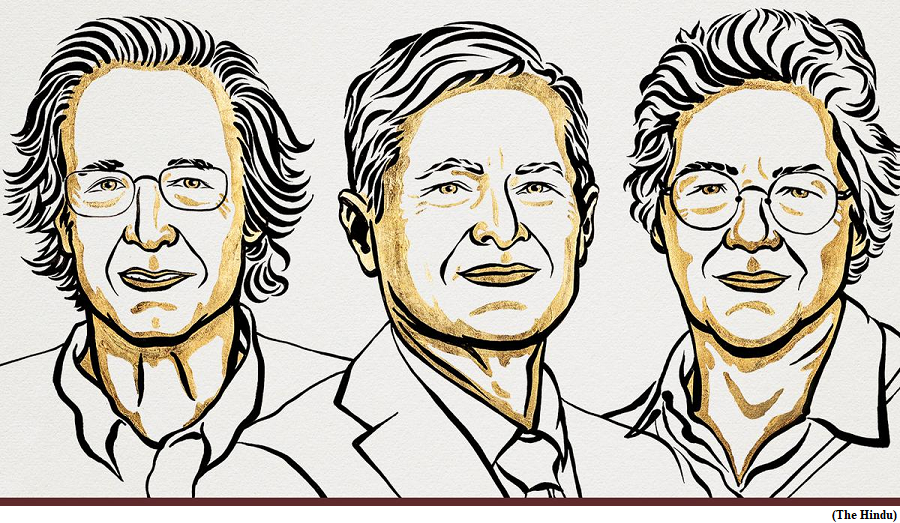Nobel Prize in Physics 2023 (GS Paper 3, Science and Technology)

Why in news?
- The Royal Swedish Academy of Sciences, Stockholm, announced Pierre Agostini, Ferenc Krausz, and Anne L’Huillier have been awarded the Nobel Prize in Physics for 2023.
Details:
- The award has been given for their experimental methods that generate attosecond pulses of light for the study of electron dynamics in matter.
- The three joint winners have given humanity new tools for exploring the world of electrons inside atoms and molecules.
- They demonstrated a way to create extremely short pulses of light that can be used to measure the rapid processes in which electrons move or change energy.
- While Anne L’Huillier discovered that many different overtones of light arose when she transmitted infrared laser light through a noble gas, Pierre Agostini succeeded in producing and investigating a series of consecutive light pulses, in which each pulse lasted just 250 attoseconds.
- Meanwhile, Ferenc Krausz experiment made it possible to isolate a single light pulse that lasted 650 attoseconds.
- An attosecond is an astonishingly short unit of time, equivalent to one quintillionth of a second, or 10^18 seconds (1 attosecond equals 0.000000000000000001 second).
What is Attosecond?
- An attosecond is an astonishingly short unit of time, equivalent to one quintillionth of a second, or 10 to the power of 18 seconds.
- If a second were stretched to cover the entire age of the universe, which is approximately 13.8 billion years, an attosecond would be just a fraction of a second.
- This incredibly brief timeframe is now being harnessed by physicists to probe and manipulate some of the most fundamental aspects of our physical world.
Why it matters?
- At this timescale, researchers can now capture the dynamics of electrons within atoms and molecules, allowing them to witness the incredibly fast processes that govern chemical reactions and electronic behavior.
- One of the most groundbreaking applications of attosecond science is the ability to create and manipulate extreme ultraviolet (XUV) and X-ray pulses, which are vital for imaging ultrafast processes at the atomic and molecular scale. These pulses are produced using high-intensity laser systems that generate attosecond bursts of light.
- With these attosecond pulses, scientists can "freeze" the motion of electrons within atoms and molecules, providing a real-time view of electron movement during chemical reactions.
Applications:
- The fundamental significance of attoseconds in physics lies in their ability to shed light on phenomena that were previously hidden from our view.
- For instance, they allow scientists to observe the quantum mechanical nature of electrons and the intricate dance they perform when interacting with one another and with atomic nuclei.
- This knowledge has profound implications for fields such as chemistry, materials science, and even the development of new technologies.
About Nobel Prize in Physics:
- The Nobel Prize in Physics is a yearly award given by the Royal Swedish Academy of Sciences to those who have made the most outstanding contributions to humankind in the field of physics.
- The tradition has been ongoing since 1901, with the prize being awarded 116 times to 222 laureates between 1901 and 2022.
- John Bardeen is the only laureate who has received the Nobel Prize in Physics twice, in 1956 and 1972.
Mass death of 120 dolphins in Amazon linked to drought, heat, lack of oxygen
(GS Paper 3, Environment)
Why in news?
- Carcasses of 120 river dolphins have been discovered floating in a tributary of the Amazon River recently. Experts believe that severe drought and heat may be the culprits behind this mass mortality.
- The Amazon River, currently experiencing low water levels due to an intense drought, has seen its waters heated to temperatures intolerable for the dolphins. This has led to a significant depletion of oxygen in the water, resulting in the death of thousands of fish.

Amazon River dolphins:
- The Amazon River dolphins, many of them strikingly pink, are a unique freshwater species found only in South American rivers.
- They are among the few remaining freshwater dolphin species in the world. Their slow reproductive cycles make their populations particularly vulnerable to threats.
- The boto and the gray river dolphin, or "tucuxi," are listed on the International Union for Conservation of Nature's red list of threatened species.
Climate Change:
- The situation turned critical when at least 70 carcasses surfaced as Lake Tefé's water temperature soared to 39 degrees Celsius, more than 10 degrees above the average for this time of year. Although the water temperature briefly declined, it rose again to 37 C, causing further concern among experts.
- Environmental activists have pointed fingers at climate change, which increases the likelihood and severity of droughts and heatwaves. However, the role of global warming in the current Amazon drought remains unclear, with factors like El Nino also potentially at play.
- Approximately 80% of the carcasses were pink dolphins, known as "botos" in Brazil. This could represent a staggering 10% loss of their estimated population in Lake Tefé.
What’s next?
- In response to this crisis, aquatic mammal experts are rescuing any surviving dolphins in the lake.
- However, these dolphins cannot be relocated to cooler river waters until a bacteriological cause of death has been ruled out.



